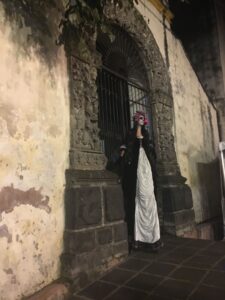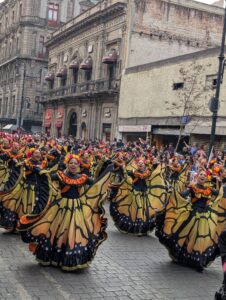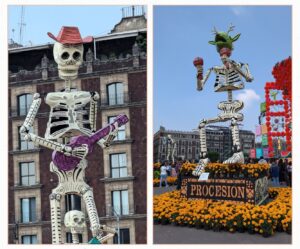
19 Nov The Day of the Dead: El Día de Muertos – A Lesson in Adapting to Change
The Day of the Dead: El Día de Muertos –
A Lesson in Adapting to Change
By Reme Bashi

A striking portrayal of La Catrina in front of an intricately carved stone archway during El Día de Muertos celebrations
If you are unfamiliar with El Día de Muertos [Day of the Dead], it’s all about honoring, celebrating and remembering loved ones who have left this world. I would like to tell you about my experience with this tradition and why it brings peace and hope to my life: I grew up in a home with a Mexican dad and an American mom. Back in the early 70s in Mexico City, El Día de Muertos tradition was not widely celebrated. However, you can leave it to a linguist’s inquisitive mind, like mine, to recall information from my childhood with great detail.
![El Día de Muertos [Day of the Dead] altar decorated with skeletons, marigold flowers, candles, sugar skulls, and various offerings.](https://najit.org/wp-content/uploads/2024/11/IMG_7976-min-225x300.jpg)
A vibrant El Día de Muertos ofrenda honoring departed loved ones, adorned with colorful marigolds, candles, sugar skulls, and traditional offerings
In a recent blog post, Something We Never Talk About, Janis Palma touched on how infrequently we speak of death and how healing it can be to do it. El Día de Muertos is an invitation to do just that. Singing, sharing food and talking about death is how we navigate loss and celebrate life. It’s all a part of the ritual in late October and early November. In Mexico, the days prior to November 1st and 2nd, newspapers publish verses called Calaveras [Skulls]. These are short, playful rhymes about prominent people in a community. The publications can ridicule politicians, criticize leaders, and remind us, no matter who we are or what we do, un día te va a llevar la calaca, [death will take you one day].
Nowadays, El Día de Muertos has gained immense popularity beyond Mexico’s borders. Many Latin American countries, along with other parts of the world, have had their own traditions for honoring the dead for centuries. At the same time, people who have recently discovered this tradition have embraced it in various ways—dressing up as skeletons, putting up decorations, or even watching a Día de Muertos-themed movie.

Dancers in vibrant butterfly-inspired dresses celebrate El Día de Muertos during a parade through the historic streets of Mexico City
In stark contrast to the relative invisibility of Día de Muertos in many parts of Mexico City just a few decades ago, the city now hosts a vibrant parade featuring elaborate floats and people dressed as catrinas y catrines [elegantly attired skeletons].
In my opinion, there are many reasons to adopt this tradition in a way that works for you and your culture. Taking the time to celebrate your ancestors and loved ones who have passed can be a way of feeling more connected to them. Making food, handcrafting decorations, or simply lighting a candle and pouring a glass of water can channel the need to feel close to those we love on the other side of the veil.
When you’re creating an ofrenda, if possible, try to use items that are either part of your everyday life or are biodegradable and handmade. There is no soul in a mass-produced plastic decoration for El Día de Muertos!
Take out your grandmother’s special china.
Play your loved one’s favorite tunes.
Sip on a beverage as you contemplate your offering to the people you honor and remember. Make a toast.
Then, dance with the living, to celebrate life.
As the offerings of the El Día de Muertos are fleeting and evolving, so is life. Change on all fronts is guaranteed. Remember to harbor hope and find new ways to build strong ties to the people around you.
![Three images: a couple dressed as Catrinas [Day of the Dead figures] with elaborate costumes, two skull-shaped tortillas served with salsa verde [green salsa], and a miniature Día de los Muertos [Day of the Dead] display featuring skeleton figures engaged in daily activities](https://najit.org/wp-content/uploads/2024/11/new-1024x540.jpg)
Reflection: Embracing Cultural Traditions for Connection and Growth
By: Julli Jaramillo
Reme Bashi’s reflection on Día de Muertos [Day of the Dead] highlights the beauty of adapting traditions over time and how tradition helps us honor those who have passed while celebrating life. As interpreters and translators, embracing cultural practices like this offers more than just a professional advantage—it fosters personal growth too. Understanding the deep cultural significance of Día de Muertos helps us navigate sensitive topics such as death and remembrance with empathy and respect, enhancing our cultural competence.
Reme’s experience of adapting the Día de Muertos celebration to fit her family’s culture reminds us that, like the offerings on an ofrenda, our work is constantly evolving. By respecting and learning from traditions like this, we enrich our ability to connect with the people we serve, providing not just accurate transfers of language but a meaningful, culturally sensitive experience.
In the end, Día de Muertos teaches us that life, like our work, is about building connections—whether through honoring the past or celebrating the living—and that the traditions we engage with, both personally and professionally, can help us navigate the changes we face.
Take a moment to reflect on the cultural traditions you encounter in your work: How can they deepen your understanding and enhance your practice as an interpreter or translator?
Share your thoughts or experiences with us in the comments, and consider how embracing these traditions can help you build stronger connections with the communities you serve.
Thanks for reading, until next time!
Now, go celebrate, make some memories, and remember: life’s for the living—so go dance like it’s a fiesta [party]!
The authors have consented to the use of their images in this blog.
Join the NAJIT Observer’s vibrant community of contributors! We are seeking passionate writers to share insights on legal translation and interpretation. Email your pitch or draft today and help shape our industry. Visit najit.org/blog for more details.
Reme Bashi has been a certified court interpreter in Wisconsin since 2008. She began her career as an interpreter and translator in Mexico, at the University of Veracruz, where she majored in pedagogy. Being bilingual in English and Spanish lead her to language teaching and then to translation and interpreting. She was a conference interpreter for several years, interpreting for the media and government events in Mexico.
In the Midwest, Bashi has interpreted in a variety of settings – education, manufacturing, legal, and community. When she’s not interpreting, she likes to learn about new subjects, something that she considers pivotal to becoming a more proficient language access professional. Recently she has immersed herself in hospitality, urban gardening, and ancestry research.
Julli Jaramillo is the newest Publishing Coordinator and Editor-in-Chief for NAJIT. She holds a master’s degree in Translation from NYU and has extensive experience in quality assurance, content development, and strategic growth. Passionate about NAJIT’s mission to uphold ethical standards for judiciary translators and interpreters, she is dedicated to driving the organization’s growth while ensuring its publications meet high-quality standards and adapt to evolving industry demands. In her free time, Julli enjoys baking and creating art.
Feel free to reach out to her (tno_editor@najit.org) to chat about the NAJIT Observer or Proteus—she is excited to collaborate!





Wonderful article, Reme! I was reminded of the first time we put up an ofrenda at home. My daughter was attending Nuestro Mundo Elementary School, a bilingual school and the young students were enjoying learning about and participating in activities related to Dia de los Muertos. So we decided to put up an ofrenda at home. We put up paper picado, treats, as well as her deceased grandfather’s favorite foods, peanut butter and popcorn! We put up flowers and pictures of my grandmother and grandfather who sacrificed everything to cross the ocean to get to this country (my grandfather was a stowaway on a ship from Poland to the US). For them there was no turning back or going back. My grandfather’s first job was cleaning the toilets at bars around Milwaukee, Wisconsin. By the time he retired he owned a respectable cleaning business. In many ways it’s because of them that we have the wonderful life we enjoy today. These past two years have been one of deep losses for us. My daughter lost her father to COPD (Chronic Obstructive Pulmonary Disease). Although we knew he was very ill, one is never ready for that loss. Never ready to tell his daughter that her dad is gone. Never ready to tell his mother that her son has passed away. wo months later I lost my very best friend and “Momtor”. And If you’ve watched Abbott Elementary on Hulu, you know that a “Momtor” means she was to me like a mother as well as a mentor. She was my “Momtor.”. I think next year we’ll have, in Reme’s words, “a chance to create the ofrenda anew, blooming with new energy, carrying forward the memories and love of those who came before.”
Dear Fayme, thanks for commenting. I’m glad this topic touched you, I think it’s especially relevant when we’ve had recent losses. I hope you and your family can engage in activities to honor the departed dad an “Momtor”. Día de Muertos can be any day of the year. Let the healing begin!
Thank you for teaching us what momtor is, dear Fayme! I didn’t know.
My sisters, aunt and niece have created altars for my dad in the past. I have not been able to yet, although it has been eight years. But hopefully I will be ready next year.
It is a beautiful custom and part of our culture. I love the colorful manifestation of love and respect.
Thank you for another meaningful post, Reme!
Thanks, Hilda for always encouraging me to continue to write!